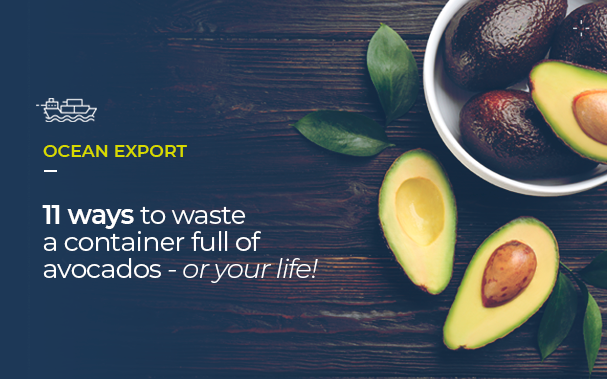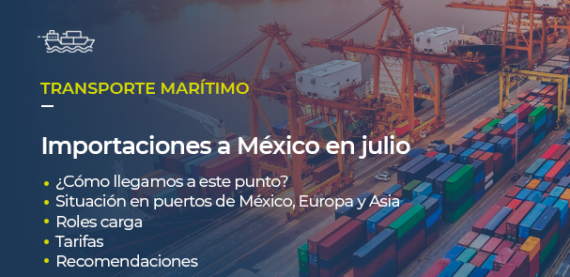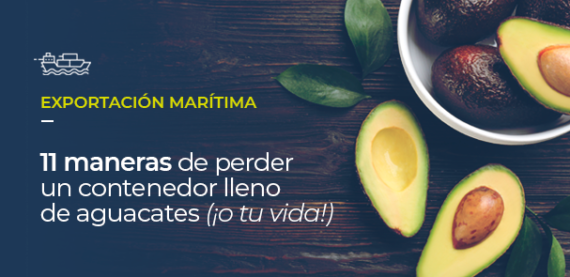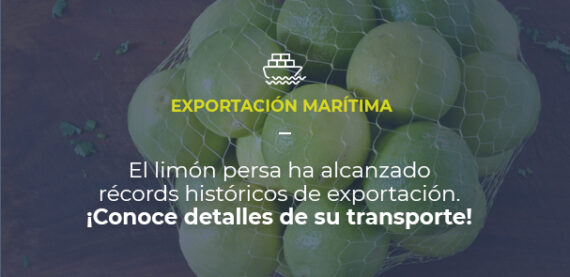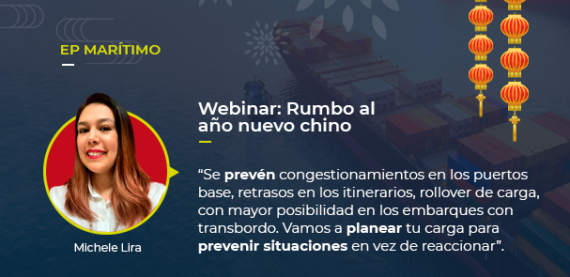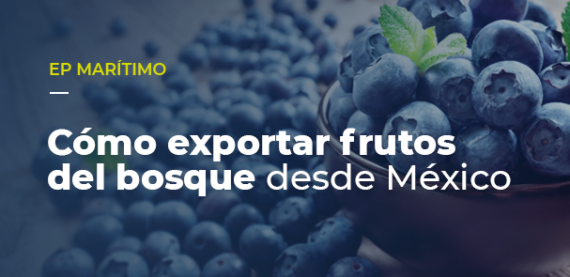We’ve organized a list with neglects or omissions that can lead you to lose a complete cargo of such valuable fruit.
The haas avocado is one of the stars of Mexican perishables exports. In fact, in a previous article, our experts detailed us how to export fresh avocados properly.
Today we want to share with you, dear exporter, what are the setbacks that you may experience in the process of exporting Mexican avocados by Ocean Freight that can transform a container with this green gold into tons of discarded fruit.
In this article, our experts from Europartners Group, your best strategic partner in logistics, point out 11 mistakes that you cannot make with an avocado cargo.
1. Programming the cargo ahead of time
2. Using the wrong packing material
3. Ignoring the pre-cooling step
4. Neglecting the temperature control between the packing warehouse and the container
5. Not using controlled atmosphere containers
6. Ignoring the container configuration
7. Not getting insurance for the product or the container
8. Not using a thermograph
9. Not recruiting an inspector
10. Start the cargo movement without having all the required documents in hand
11. Not waiting long enough before opening the container
Avocado export mistakes you must avoid at any cost
1. Programming the cargo ahead of time
As we will see all over this article, exporting fresh avocado requires a high level of precision, organization, and attention to important details. The whole strategy must be carefully built; however, this doesn’t really mean that you must make a reservation with the shipping companies too long before the day you think your cargo should leave the port.
Refrigerated cargo is a priority shipment. In the case of avocados, even with the recent crisis of spaces for shipping companies, the departure date should be scheduled with the shipping line as close as possible to the ship’s estimated departure date. When planning, it is very important to get a list of vessels that are close to the available port alternatives, and to choose the most suitable option that takes your cargo where it needs to be, on time.
That does not mean that a request can be placed overnight, either. Shipping companies usually don’t keep refrigerated containers in Mexico. They need a few days (or weeks) to have the container available, and send it to Mexico to be loaded it with the perishables that will be exported.
So “how can I determine the correct date to make the reservation, then?”, you ask us. Starting from a well-planned forecast, which considers from the harvest to the date the cargo must reach the consignee – and with a strategic partner in logistics at your side, such as Europartners Group.
With well-trained, experienced teams constantly updated on the market situation, we can design a solution tailored to your needs to export avocado, with the correct programming, negotiating documentary and dispatch deliveries as close to the date of departure as possible. With this, we also enable shipping companies to build more solid stowage plans, reducing the time of loading in the port and the risks of not having enough space.
2. Using the wrong packing material

The avocado travels in fruit crates (or cartons), which must be specially made for refrigerated cargo, with specially designed openings to enable air circulation through the fruits, which removes internal heat.
3. Ignoring the pre-cooling step
On average, the temperature to export avocado is between 39.2°F and 42.8°F (4°C to 6°C). Higher temperatures can accelerate the fruit ripening.
Refrigerated containers are not made to cool, but to maintain temperature.
To avoid issues, the good practice is that, in the packing plant, the fruit must go through a cooling system, generally using wind tunnels for simulation of forced air, for an amount of time specially calculated so that it reaches the ideal temperature to be transported without losing quality.
During the loading maneuver, the avocado must already be “in range”, that is, it must be at the correct temperature. If the fruit is loaded at a higher temperature, the container will emit cold air currents to reach the programmed temperature, generating thermal shocks. As a result, the fruit will arrive at its destination damaged.
4. Neglecting the temperature control between the packing warehouse and the container
With the export avocado properly packed and pre-cooled, it is time for a short, fast step – but it is one that can negatively impact the quality in which the avocado reaches its destination: the transfer from the warehouse to the container.
The pre-cooled avocado must never be subjected to a higher temperature. The warehouse in which it is stored waiting for the transport is refrigerated, and the container must also arrive at the loading site already with the correct temperature, after going through a procedure of the shipping company known as Pre-Trip Inspection (PTI).
During the PTI, the container is tested to confirm that the equipment is in prime condition to hit the road and is unlikely to break down.
When the carrier arrives with the trailer at the packing plant, the container must be positioned with the doors directed to the exit ramp of the warehouse, so that forklifts operators, well equipped with protective clothing against low temperatures, can move the cargo through an airtight tunnel which doesn’t allow a “cold leak” (temperature change) between the two sites.
When loaded to the Ground Freight unit, the container works independently of the vehicle, powered by a motor generator. Thus, a failure in the trailer doesn’t harm the system that keeps the cargo cool.
5. Not using controlled atmosphere containers
To avoid that the product loses quality during Ocean Freight, the avocado must be necessarily transported in containers with controlled atmosphere.
This is one of the most important points in a process to export avocado from Mexico. In fact, selecting the container that best suits the needs of the cargo is essential in any maritime movement.
“Care of the cargo during the voyage must be aimed at controlling respiration processes (release of CO2, water vapor, ethylene and heat) in such a way that the cargo is at the desired stage of ripeness on reaching its destination.”
Source: German Government Transport Information Service.
Extra details: the correct placement of the hermetic curtain and the ethylene filter
The refrigerated container doesn’t arrive at the packing plant with all the necessary details to transport of perishables in a controlled atmosphere.
Once the avocado boxes are placed in the refrigerated container, it is necessary to install a plastic curtain in the frame of the container door, to prevent loss of the internal gases that maintain the temperature of the cargo.
It is equally important to position the disposable ethylene remover filter from the container’s controlled atmosphere, as this gas accelerates the ripening and overripening of the fruit.
6. Ignoring the container configuration
The temperature and gas concentration set in the container depends on the amount of dry matter in the product.
Check out the fun facts in the last section of this article for more details.
7. Not getting insurance for the product or the container
Responsible freight forwarders, such as Europartners Group, do not move refrigerated cargo that is not insured.
One of the first questions asked to a client in the negotiation for a movement to export avocado is “Does your company have cargo insurance, or do you want us to give you alternatives?”
Some companies already have global policies. If necessary, we can offer the service.
Types of insurance
In some situations, refrigerated cargo requires two types of insurance:
- Product insurance
- Container insurance
Note: container insurance is only necessary when it is not the shipping company that provides ground transportation.
8. Not using a thermograph
The refrigerated container has computers and sensors integrated that report the temperature all over the product’s journey; however, said report is not shared with the client.
In case of damage to the merchandise on arrival, insurers require a record of the temperature history, from loading to delivering to the consignee. This documentation is draw up by the thermographer, which records the temperature throughout the trip.
9. Not recruiting an inspector
Usually, when a cargo agent recruits the services of a shipping company, the work of an inspector –a professional expert in the placement of ethylene filters inside the container, as well as the placement of the hermetic curtain– is already in the contract.
However, there are exceptions, and it is important to make sure you make an appointment with a freight inspector from a specialized company, as he/she will verify that the product is within the correct range (temperature) to be loaded.
If the temperature is not adequate, the shipping company will be informed, so it can be dissociated from any possible damage or future claim.
10. Start the cargo movement without having all the required documents in hand
There is always the risk that the bureaucracy can make the documentation procedures for the export of avocado slower than the transport of the cargo itself.
Incomplete documentation prevents the release of the load from the port, generating connection costs and an increase in transport days, which can damage the fruit or affect its quality on arrival.
Arriving without the originals at the destination can also be a problem.
11. Not waiting long enough before opening the container
 This can be literally life-threatening.
This can be literally life-threatening.
Controlled atmosphere cargo travels with a “serious hazard to health” label.
The concentration of gas inside this type of container is different from what we breathe.

Breathing the air that comes out of the refrigerated container can cause severe poisoning that results in a quick death.
The correct process for handling the refrigerated container at destination is:
- Turning it off.
- The container will regulate the gas levels with the normal atmosphere, for a few hours.
- Opening the doors and removing the airtight curtain.
Why should you export avocado with Europartners Group?
We are very experienced in the process, good practices, transport modes and routes to export avocado from Mexico – and we have a clear view of everything that should not be done when moving this “green gold”.
Would you like to access some guides on how to export other perishable products? Click here to see our previous articles!
Our teams are often in training and update sessions on perishables transportation processes, to build detailed, coordinated and precisely executed checklists.
Contact us now to get a high-level consultancy!

 ESPAÑOL
ESPAÑOL





